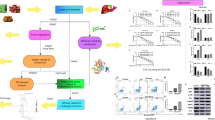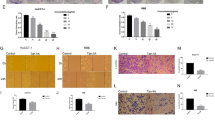Abstract
Cholangiocarcinoma (CCA) is a type of malignant tumor originating from the intrahepatic, periportal, or distal biliary system. The treatment means for CCA is limited, and its prognosis is poor. Spatholobi Caulis (SC) is reported to have effects on anti-inflammatory and anti-tumor, but its role in CCA is unclear. First, the potential molecular mechanism of SC for CCA treatment was explored based on network pharmacology, and the core targets were verified by molecular docking and molecular dynamics simulation. Then, we explored the inhibitory effect of SC on the malignant biological behavior of CCA in vitro and in vivo and also explored the related signaling pathways. The effect of combination therapy of SC and cisplatin (DDP) in CCA was also explored. Finally, we conducted a network pharmacological study and simple experimental verification on luteolin, one of the main components of SC. Network pharmacology analysis showed that the core targets of SC on CCA were AKT1, CASP3, MYC, TP53, and VEGFA. Molecular docking and molecular dynamics simulation indicated a good combination between the core target protein and the corresponding active ingredients. In vitro, SC inhibited proliferation, migration, invasion, and epithelial-mesenchymal transition (EMT) of CCA cells. In vivo experiments, the results were consistent with in vitro experiments, and there was no significant hepatorenal toxicity of SC at our dosage. Based on KEGG enrichment analysis, we found PI3K/AKT signaling pathway might be the main signaling pathway of SC action on CCA by using AKT agonist SC79. To explore whether SC was related to the chemotherapy sensitivity of CCA, we found that SC combined with DDP could more effectively inhibit the progression of cholangiocarcinoma. Finally, we found luteolin may inhibit the proliferation and invasion of CCA cells. Our study demonstrates for the first time that SC inhibits the progression of CCA by suppressing EMT through the PI3K-AKT signaling pathway, and SC could enhance the effectiveness of cisplatin therapy for CCA.









Similar content being viewed by others
Data availability
Data and materials are available from the corresponding author on reasonable request.
References
Agrawal P, Singh H, Srivastava HK et al (2019) Benchmarking of different molecular docking methods for protein-peptide docking. BMC Bioinformatics 19(Suppl 13):426
Badshah SL, Faisal S, Muhammad A et al (2021) Antiviral activities of flavonoids. Biomed Pharmacother 140:111596
Bae SJ, Bak SB, kim YW (2022) Coordination of AMPK and YAP by Spatholobi Caulis and procyanidin B2 provides antioxidant effects in vitro and in vivo. Int J Mol Sci 23(22):13730
Bae SJ, Lee WY, Bak SB et al (2023) Unraveling the antioxidant capacity of Spatholobi Caulis in nonalcoholic fatty liver disease: a multiscale network approach integrated with experimental validation. Antioxidants (Basel) 12(5):1097
Banales JM, Marin JJG, Lamarca A et al (2020) Cholangiocarcinoma 2020: the next horizon in mechanisms and management. Nat Rev Gastroenterol Hepatol 17(9):557–588
Brindley PJ, Bachini M, Ilyas SI et al (2021) Cholangiocarcinoma. Nat Rev Dis Primers 7(1):65
Calis Z, Mogulkoc R, Baltaci AK (2020) The roles of flavonols/flavonoids in neurodegeneration and neuroinflammation. Mini Rev Med Chem 20(15):1475–1488
Dongre A, Weinberg RA (2019) New insights into the mechanisms of epithelial-mesenchymal transition and implications for cancer. Nat Rev Mol Cell Biol 20(2):69–84
Gigante E, Hobeika C, Le Bail B et al (2022) Systemic treatments with tyrosine kinase inhibitor and platinum-based chemotherapy in patients with unresectable or metastatic hepatocholangiocarcinoma. Liver Cancer 11(5):460–73
Ji D, Zheng W, Huang P et al (2020) Huaier restrains cholangiocarcinoma progression in vitro and in vivo through modulating lncRNA TP73-AS1 and inducing oxidative stress. Onco Targets Ther 13:7819–7837
Jiashuo WU, Fangqing Z, Zhuangzhuang LI et al (2022) Integration strategy of network pharmacology in traditional Chinese medicine: a narrative review. J Tradit Chin Med 42(3):479–486
Khan SA, Tavolari S, Brandi G (2019) Cholangiocarcinoma: epidemiology and risk factors. Liver Int 39(Suppl 1):19–31
Li JJ, Liang Q, Sun GC (2021) Traditional Chinese medicine for prevention and treatment of hepatocellular carcinoma: a focus on epithelial-mesenchymal transition. J Integr Med 19(6):469–477
Luo H, Vong CT, Chen H et al (2019) Naturally occurring anti-cancer compounds: shining from Chinese herbal medicine. Chin Med 14:48
Moris D, Palta M, Kim C et al (2023) Advances in the treatment of intrahepatic cholangiocarcinoma: an overview of the current and future therapeutic landscape for clinicians. CA Cancer J Clin 73(2):198–222
Nogales C, Mamdouh ZM, List M et al (2022) Network pharmacology: curing causal mechanisms instead of treating symptoms. Trends Pharmacol Sci 43(2):136–150
Pan Y, Luo X, Gong P (2023) Spatholobi caulis: a systematic review of its traditional uses, chemical constituents, biological activities and clinical applications. J Ethnopharmacol 317:116854
Peng Y, Wang Y, Zhou C et al (2022) PI3K/Akt/mTOR pathway and its role in cancer therapeutics: are we making headway? Front Oncol 12:819128
Sapisochin G, Ivanics T, Subramanian V et al (2020) Multidisciplinary treatment for hilar and intrahepatic cholangiocarcinoma: a review of the general principles. Int J Surg 82S:77–81
Shen Q, Han Y, Wu K et al (2022) MrgprF acts as a tumor suppressor in cutaneous melanoma by restraining PI3K/Akt signaling. Signal Transduct Target Ther 7(1):147
Slika H, Mansour H, Wehbe N et al (2022) Therapeutic potential of flavonoids in cancer: ROS-mediated mechanisms. Biomed Pharmacother 146:112442
Sun Z, Su YH, Yue XQ (2008) Professor Ling Changquan’s experience in treating primary liver cancer: an analysis of herbal medication. Zhong Xi Yi Jie He Xue Bao 6(12):1221–5
Sun L, Li Q, Guo Y et al (2020) Extract of Caulis Spatholobi, a novel platelet inhibitor, efficiently suppresses metastasis of colorectal cancer by targeting tumor cell-induced platelet aggregation. Biomed Pharmacother 123:109718
Sun B, Ding B, Chen Y et al (2023) AFAP1L1 promotes gastric cancer progression by interacting with VAV2 to facilitate CDC42-mediated activation of ITGA5 signaling pathway. J Transl Med 21(1):18
Suo H, Hochnadel I, Petriv N et al (2022) Elucidating the mechanism behind and investigating the efficacy of traditional Chinese medicine and traditional Tibetan medicine in combination with standard therapeutics in hepatocellular carcinoma and cholangiocarcinoma in vitro. Front Pharmacol 13:906468
Tewari D, Patni P, Bishayee A et al (2022) Natural products targeting the PI3K-Akt-mTOR signaling pathway in cancer: a novel therapeutic strategy. Semin Cancer Biol 80:1–17
Wang N, Wang J, Meng X et al (2018) 3D microfluidic in vitro model and bioinformatics integration to study the effects of Spatholobi Caulis tannin in cervical cancer. Sci Rep 8(1):12285
Wang X, Wang ZY, Zheng JH et al (2021) TCM network pharmacology: a new trend towards combining computational, experimental and clinical approaches. Chin J Nat Med 19(1):1–11
Wen K, Fang X, Yang J et al (2021) Recent research on flavonoids and their biomedical applications. Curr Med Chem 28(5):1042–1066
Xiang Y, Guo Z, Zhu P et al (2019) Traditional Chinese medicine as a cancer treatment: modern perspectives of ancient but advanced science. Cancer Med 8(5):1958–1975
Yang Q, Jiang W, Hou P (2019) Emerging role of PI3K/AKT in tumor-related epigenetic regulation. Semin Cancer Biol 59:112–124
Yu L, Wei J, Liu P (2022) Attacking the PI3K/Akt/mTOR signaling pathway for targeted therapeutic treatment in human cancer. Semin Cancer Biol 85:69–94
Yuan Z, Pan Y, Leng T et al (2022) Progress and prospects of research ideas and methods in the network pharmacology of traditional Chinese medicine. J Pharm Pharm Sci 25:218–226
Zhang Y, Lou Y, Wang J et al (2020) Research status and molecular mechanism of the traditional Chinese medicine and antitumor therapy combined strategy based on tumor microenvironment. Front Immunol 11:609705
Zhang X, Qiu H, Li C et al (2021) The positive role of traditional Chinese medicine as an adjunctive therapy for cancer. Biosci Trends 15(5):283–298
Zhao L, Zhang H, Li N et al (2023) Network pharmacology, a promising approach to reveal the pharmacology mechanism of Chinese medicine formula. J Ethnopharmacol 309:116306
Funding
This study was supported by grants from the following organizations: Hunan Provincial Natural Science Foundation (no. 2022JJ30339), Project of Hunan Provincial Health Commission (no. 202204013663, no. 202204013536 and no.202204014077), Excellent Youth Project of Hunan Provincial Education Department (no. 21B0036), Natural Science Foundation of Changsha (no. kq2007075).
Author information
Authors and Affiliations
Contributions
All authors contributed to the study conception and design. Xu Chen and Bo Sun performed the material preparation and data collection; Zhiguo Tan and Jie Liu contributed significantly to the date analysis and manuscript preparation; Xu Chen and Jia Zeng wrote the first draft of the manuscript; Yuhang Li and Zhangtao Yu contributed to the conception of the study; Xu Chen, Bo Sun and Chuang Peng helped perform the analysis with constructive discussions. All authors read and approved the final manuscript. The authors declare that all data were generated in-house and that no paper mill was used.
Corresponding authors
Ethics declarations
Ethical approval
The animal study was reviewed and approved by the Hunan Province Experimental Animal Management Committee.
Competing interests
The authors have declared that no competing interest exists.
Additional information
Publisher's Note
Springer Nature remains neutral with regard to jurisdictional claims in published maps and institutional affiliations.
Supplementary Information
Below is the link to the electronic supplementary material.
Rights and permissions
Springer Nature or its licensor (e.g. a society or other partner) holds exclusive rights to this article under a publishing agreement with the author(s) or other rightsholder(s); author self-archiving of the accepted manuscript version of this article is solely governed by the terms of such publishing agreement and applicable law.
About this article
Cite this article
Chen, X., Sun, B., Zeng, J. et al. Molecular mechanism of Spatholobi Caulis treatment for cholangiocarcinoma based on network pharmacology, molecular docking, and molecular dynamics simulation. Naunyn-Schmiedeberg's Arch Pharmacol (2024). https://doi.org/10.1007/s00210-024-02985-0
Received:
Accepted:
Published:
DOI: https://doi.org/10.1007/s00210-024-02985-0




